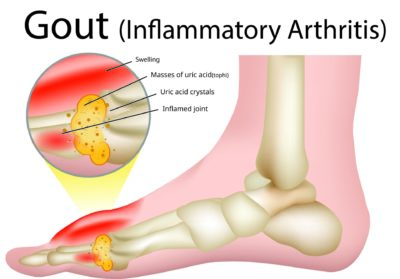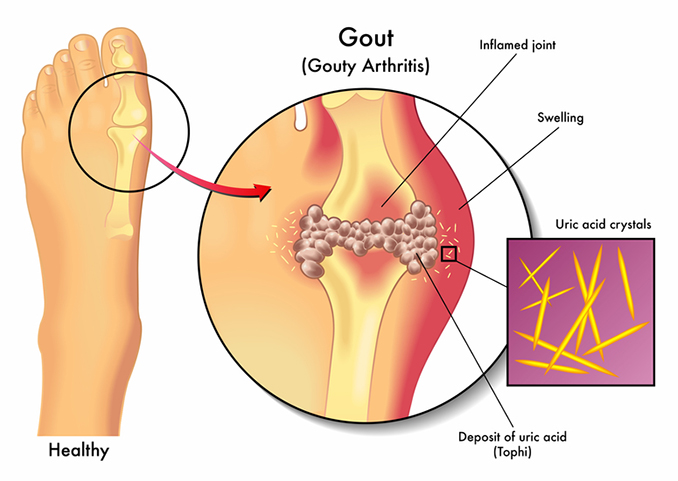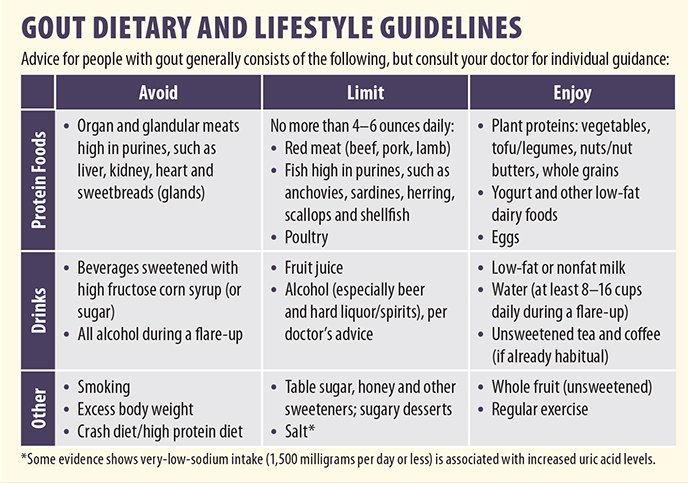Explore groundbreaking advancements in gout management, from genetic research to innovative dietary approaches. Discover how emerging treatments and lifestyle modifications can transform your journey towards overcoming gout.

Introduction
Gout, a form of inflammatory arthritis, emerges from the accumulation of uric acid in the body, leading to severe joint pain and discomfort. This article delves into the root causes, risk factors, and effective management strategies for gout, offering a comprehensive guide to understanding and combating this condition. With insights into the latest research and future directions in gout treatment, we aim to empower individuals with the knowledge and tools needed for improved health and quality of life.
Table of Contents
What Causes Gout?
Gout is a form of inflammatory arthritis triggered by hyperuricemia, a condition characterized by an excess of uric acid in the body. This excess occurs as the body processes purines, substances found in the body and in various foods. When uric acid levels become too high, urate crystals can form in and around the joints, leading to painful gout attacks.

Risk Factors and Management Strategies
Dietary Habits
Influence: High-purine foods such as red meats, certain seafood, fructose-sweetened drinks, and alcohol, particularly beer and spirits, can elevate uric acid levels.
Management: Opt for a balanced diet rich in fruits, vegetables, whole grains, and low-fat dairy products. Limit consumption of high-purine foods and sugary beverages.
Obesity
Influence: Excess weight can increase uric acid production and hinder the kidneys’ ability to eliminate it, facilitating the formation of urate crystals in joints.
Management: Implement a weight management plan that includes healthy eating habits and regular physical activity. Even modest weight loss can reduce the risk of gout attacks.
Medical Conditions
Influence: Conditions such as high blood pressure, diabetes, metabolic syndrome, and chronic diseases of the kidneys and heart can disrupt uric acid balance.
Management: Collaborate with healthcare professionals to manage these conditions effectively through medication, lifestyle modifications, and regular check-ups.
Family History
Influence: A genetic predisposition to gout can increase your risk due to inherited factors affecting uric acid metabolism.
Management: Awareness of your family history can prompt early adoption of preventive lifestyle changes and seeking medical guidance.
Age and Gender
Influence: Men, especially those between 30 to 50 years old, and postmenopausal women have higher risks of developing gout due to elevated uric acid levels.
Management: Acknowledge the influence of age and gender on gout risk and make appropriate lifestyle and health monitoring decisions.
Medications
Influence: Certain medications, including diuretics for blood pressure, low-dose aspirin, and anti-rejection drugs for organ transplants, can increase uric acid levels.
Management: Consult with your healthcare provider about the effects of your medications on uric acid levels and consider alternative treatments or preventive measures.
By understanding these risk factors and implementing effective management strategies, individuals can significantly reduce their risk of developing gout or manage their condition more effectively, leading to improved health and quality of life.
Understanding Gout Symptoms
Gout is characterized by sudden and severe joint pain, often occurring at night and capable of disrupting sleep. This intense pain typically affects the big toe but can also impact ankles, knees, wrists, fingers, and elbows.
Peak Pain
The most severe pain usually hits within the first 24 hours, with symptoms gradually subsiding over the following days to a week if left untreated.
Following the initial attack, joints may remain sore and tender, a discomfort that can persist for days to weeks, particularly with recurring gout episodes.
Visible Changes
Affected joints may show noticeable swelling, redness, and warmth, with the skin appearing shiny and stretched over them.
If not properly managed, gout symptoms can fluctuate, but understanding and addressing them can help manage discomfort and prevent future flare-ups. Long-term implications include:
Joint Damage
Repeated gout attacks can lead to lasting joint damage, chronic pain, and reduced mobility, affecting daily life.
Tophi Development
Persistent gout can result in tophi, which are nodules under the skin formed from urate crystal deposits. These lumps can become sore during gout attacks.
Kidney Stones
The high uric acid levels that cause gout can also lead to kidney stone formation, posing additional health risks.

Reduced Joint Mobility
Additional Indicators of Gout
Recognizing these symptoms early and seeking appropriate management can mitigate the impact of gout on your health and quality of life.
Gout Management and Treatment Approaches

Lifestyle Changes and Home Remedies
Dietary Changes
Overview: High-purine foods can lead to increased levels of uric acid, triggering gout attacks. Foods such as red meats, certain types of seafood, and organ meats are high in purines.
Recommendations: Opt for a diet that emphasizes plant-based proteins, like lentils and beans, along with low-fat dairy products and whole grains. Adding cherries to your diet may also reduce the risk of gout attacks.


Staying Hydrated
Importance: Proper hydration helps to dilute uric acid in the blood and facilitates its removal from the body.
Guidelines: Aim for 8-10 glasses of water per day, adjusting based on activity level and environmental factors.
Alcohol and Sugary Beverages
Impact: Alcohol, especially beer, and drinks sweetened with fructose can increase uric acid levels.
Advice: Moderate alcohol consumption and prefer water, herbal teas, or diluted fruit juices over sugary drinks.


Weight Management
Significance: Higher body weight can lead to increased production of uric acid and reduce the efficiency of the kidneys in filtering it out.
Strategy: Maintain a balanced diet and regular exercise to achieve and sustain a healthy weight. Even modest weight loss can significantly lower uric acid levels.
Medical Treatments
For Immediate Gout Flare-ups
NSAIDs: Nonsteroidal anti-inflammatory drugs, such as ibuprofen, help reduce inflammation and pain. Colchicine is an alternative for those who cannot take NSAIDs.
Colchicine: Effective especially when taken early during a flare-up, it can significantly reduce gout pain.
Corticosteroids: Medications like prednisone can be taken orally or injected directly into the inflamed joint to relieve pain and inflammation.
Preventive Medications
Uric Acid Blockers: Drugs like allopurinol and febuxostat decrease the production of uric acid, aiding in the prevention of future attacks.
Uricosurics: These medications, including probenecid, increase the kidneys’ ability to remove uric acid from the body, thus reducing its accumulation.
Ongoing Management
Monitoring: Regular check-ups with a healthcare professional are essential to monitor uric acid levels and adjust treatment as necessary.
Lifestyle Reevaluation: Continuously revising and adapting your diet, exercise regimen, and medication adherence is crucial for effective long-term management of gout.
Emerging Research and Prospects in Gout Treatment
As we delve into the complexities of gout management, ongoing advancements in medical research are opening new avenues for innovative treatments and enhancing our comprehension of this ailment. This segment highlights the forefront of gout research and the promising future directions that offer hope and novel opportunities for individuals grappling with this debilitating condition.
Advancements in Gout Research
Genetic Research: Researchers are exploring the genetic underpinnings of gout, with the goal of pinpointing specific genes that affect uric acid processing and the inflammatory response. This could pave the way for tailored treatments based on genetic profiles, significantly improving the effectiveness of gout management.
Innovative Medications: The pursuit of new drugs that target various mechanisms of uric acid regulation and inflammation presents a beacon of hope. These efforts include the creation of drugs that more efficiently lower uric acid levels and new anti-inflammatory treatments to mitigate the symptoms of gout flare-ups.
Biomarker Identification: The search for biomarkers capable of forecasting gout attacks or assessing the condition’s severity is underway. Such markers would revolutionize early gout detection and enable a more anticipatory approach to treatment.
Diet and the Gut Microbiome: Recent research is examining the relationship between dietary habits, the gut microbiome, and gout risk. Insights into how diet and gut bacteria influence uric acid levels could inform dietary guidelines to prevent gout episodes.
Future Directions in Gout Care
Telehealth and Digital Tools: Telemedicine and digital health solutions, including apps for symptom tracking and medication management, are gaining traction in gout care. These tools promise enhanced patient-provider interaction and tailored patient care.
Lifestyle Intervention Programs: Studies on comprehensive lifestyle interventions that incorporate dietary changes, physical activity, and weight management are assessing their impact on alleviating gout symptoms and enhancing life quality. These programs advocate for a holistic approach to managing gout, extending beyond pharmacological treatments.
Public Health Efforts: Initiatives focused on increasing awareness about gout and its risk factors are essential for its prevention. Public education campaigns aimed at promoting early detection and intervention can play a pivotal role in diminishing the prevalence and adverse effects of gout across communities.
These innovative research endeavors and future strategies underscore a dynamic and evolving landscape in gout management, offering renewed hope and practical pathways for individuals affected by gout to achieve better health outcomes.
Frequently Asked Questions
Q: What are the primary causes of gout?
A: Gout is primarily caused by hyperuricemia, a condition where the body has excessive uric acid levels due to the breakdown of purines found in certain foods and the body itself.
Q: How can diet influence gout?
A: Consuming high-purine foods, fructose-sweetened drinks, and excessive alcohol can elevate uric acid levels, triggering gout flare-ups. A balanced diet rich in fruits, vegetables, and low-fat dairy can help manage and prevent gout.
Q: What lifestyle changes can help manage gout?
A: Key strategies include maintaining a healthy weight, staying hydrated, limiting alcohol and sugary beverages, and engaging in regular physical activity.
Q: Are there any new treatments for gout on the horizon?
A: Ongoing research focuses on genetic factors, innovative medications, and the role of diet and the gut microbiome in gout management, promising more personalized and effective treatment options in the future.
Conclusion
Gout management is evolving, with cutting-edge research and holistic approaches offering new hope for those affected. By understanding the underlying causes and implementing strategic lifestyle changes, individuals can significantly reduce the impact of gout. Future advancements in treatment promise even greater success in managing this condition, emphasizing the importance of staying informed and proactive in gout care. As we look forward to these developments, embracing a comprehensive approach to gout management remains crucial for achieving optimal health and well-being.
| Arch Support |
| Arch Supports |
| Best Arch Support Insoles |
| Best Insole for Plantar Fasciitis |
| Insole for Flat Feet |


MOST COMMENTED
Animal-Based Proteins / Casein Protein / Dietary Protein / High-Protein Diets / Pea Protein / Plant-Based Proteins / Protein / Protein Deficiency / Protein Supplements / Proteins / Whey Protein / Whey Proteins
Is Protein Powder Safe for Teenagers and Children?
Animal-Based Proteins / Casein Protein / Dietary Protein / High-Protein Diets / Pea Protein / Plant-Based Proteins / Protein / Protein Deficiency / Protein Supplements / Proteins / Whey Protein / Whey Proteins
Unlock the Power of Proteins for Optimal Gut Health
Multivitamin
Total Health: Multivitamin for Active Lifestyles
Multivitamin
WellnessFusion: Complete Multivitamin Support
Dietary Supplement
Revitalize Your Health: The Magic of Red Yeast Rice Capsules
Foot care / Foot Health
Revitalize Your Foot Care Routine: Essential Tips for Optimal Foot Health
Foot Problem / Diabetics / Foot Health
Diabetics: Mastering Footwear Selection for Enhanced Foot Health and Ultimate Comfort
Exercises and Footwear Tips for Hammertoe Relief / Foot care / Foot Health / Foot Pain / Foot Problem / Hammertoes
Unlock Effective Exercises and Footwear Tips for Hammertoe Relief
Hammertoes / Foot Health / Foot Pain / Foot Problem
Unlock Relief: Essential Guide to Hammertoes Causes, Symptoms, and Treatments
Foot Problem / Foot Health
Revolutionize Your Recovery: Natural Remedies for Plantar Fasciitis – Fresh Home Keepers